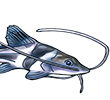How to differentiate between agassazii, ambiacus & lambe
How to differentiate between agassazii, ambiacus & lambe
Over here at Singapore, we have a few batches of cories that looks very similiar to each other. They look very much like agassazii, ambiacus or even lamberti? Can anyone give a definite guide on how to differentiate them? I will try to post pictures later 
- Coryman
- Expert
- Posts: 2119
- Joined: 30 Dec 2002, 19:06
- My articles: 12
- My catfish: 5
- My cats species list: 83 (i:3, k:0)
- My BLogs: 1 (i:0, p:46)
- Spotted: 194
- Location 1: Kidderminster UK
- Location 2: Kidderminster, UK
- Interests: Cory's, Loricariids, photography and more Cory's
- Contact:
Thanks Ian for the prompt reply! It is precisely the agassizii and ambiacus that is giving me the headache  I've taken a look at the pictures and could not figure out the differences
I've taken a look at the pictures and could not figure out the differences 
The only diff I see of the 3 is that c.lamberti has only a black blotch at the tip of the dorsal fin whereas the agassazii/ambiacus has a black strip from the shoulder ro the tip of the dorsal fin.
The only diff I see of the 3 is that c.lamberti has only a black blotch at the tip of the dorsal fin whereas the agassazii/ambiacus has a black strip from the shoulder ro the tip of the dorsal fin.
- Coryman
- Expert
- Posts: 2119
- Joined: 30 Dec 2002, 19:06
- My articles: 12
- My catfish: 5
- My cats species list: 83 (i:3, k:0)
- My BLogs: 1 (i:0, p:46)
- Spotted: 194
- Location 1: Kidderminster UK
- Location 2: Kidderminster, UK
- Interests: Cory's, Loricariids, photography and more Cory's
- Contact:
- corydorus
- Posts: 83
- Joined: 02 Mar 2003, 04:25
- Location 1: Singapore and Taiwan
- Interests: Books, Corys and Planted Tank
- Contact:
Ian, just curious with differences so little and considering there are so many var. inbetwee, any possibilities same species afterall ?
Why would someone say they are 2 separate species ?
Is it they have very concrete way of measure like maybe one has sligthly different skeleton structures etc that are not visible externally ?
Why would someone say they are 2 separate species ?
Is it they have very concrete way of measure like maybe one has sligthly different skeleton structures etc that are not visible externally ?
- Coryman
- Expert
- Posts: 2119
- Joined: 30 Dec 2002, 19:06
- My articles: 12
- My catfish: 5
- My cats species list: 83 (i:3, k:0)
- My BLogs: 1 (i:0, p:46)
- Spotted: 194
- Location 1: Kidderminster UK
- Location 2: Kidderminster, UK
- Interests: Cory's, Loricariids, photography and more Cory's
- Contact:
Its down to location of the individuals, although two fish may look identical, because they are separated geographically buy hundreds if not thousands of Killometers, C. julii and C. trilineatus are a tipical examples. There is no way that they could have evolved as the same species.
This is why great importance is given to type locality, without knowing where a fish has come from it is very difficult to identify it with any accuracy.
Ian
This is why great importance is given to type locality, without knowing where a fish has come from it is very difficult to identify it with any accuracy.
Ian
C. ambiacus is variable in patterning. in the fishes i've seen for sale, at least 3 out of 4 of them are young C. ambiacus. the rest are C. lamberti. C. agassizii have smaller and lighter spots as compared to the true ambiacus. apart from the dorsal blotch, the only other difference between ambiacus and agassizii is the extent of black on the dorsal with agassizii having a weaker black presence. there have been imports recently with fish being called the true robustus but they turned out to be agassizii instead.
fishes... simply irresistable 
- Jools
- Expert
- Posts: 16266
- Joined: 30 Dec 2002, 15:25
- My articles: 198
- My images: 941
- My catfish: 237
- My cats species list: 87 (i:235, k:1)
- My BLogs: 7 (i:10, p:167)
- My Wishlist: 23
- Spotted: 450
- Location 1: Middle Earth,
- Location 2: Scotland
- Interests: All things aquatic, Sci-Fi, photography and travel. Oh, and beer.
- Contact:
I'm going over to the taxonomy forum with a new post about some of this as something has been troubling me about it for while now. It's at http://www.forum.planetcatfish.com/viewtopic.php?t=3237.Coryman wrote:Its down to location of the individuals, although two fish may look identical, because they are separated geographically buy hundreds if not thousands of Killometers, C. julii and C. trilineatus are a tipical examples. There is no way that they could have evolved as the same species.
This is why great importance is given to type locality, without knowing where a fish has come from it is very difficult to identify it with any accuracy.
Ian
Jools
Owner, AquaticRepublic.com, PlanetCatfish.com & ZebraPleco.com. Please consider donating towards this site's running costs.








